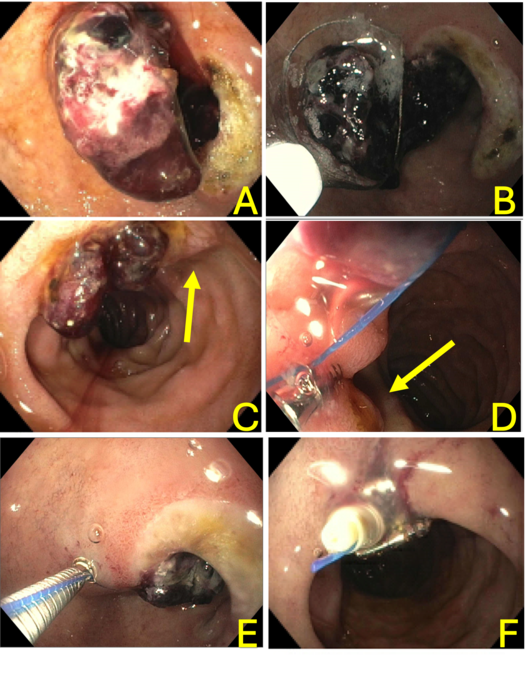Tuesday Poster Session
Category: Small Intestine
P6298 - Through-the-Scope Suturing for Hemostasis of a High-Risk Duodenal Ulcer Near the Ampulla: A Targeted Strategy to Maintain Ampullary Patency
Tuesday, October 28, 2025
10:30 AM - 4:00 PM PDT
Location: Exhibit Hall

Mina Awadallah, MD, MSc
University of Utah
Salt Lake City, UT
Presenting Author(s)
Mina Awadallah, MD, MSc1, Kathryn R. Byrne, MD2, John Erikson Yap, MD, MBA, FACG3
1University of Utah, Salt Lake City, UT; 2University of Utah School of Medicine, Salt Lake City, UT; 3University of Utah Health, Salt Lake City, UT
Introduction: Duodenal ulcers with high-risk stigmata, such as large visible vessels, often require endoscopic therapy using thermal coagulation or mechanical clips. Over-the-scope clips (OTSCs) are highly effective, particularly for large-caliber vessels due to their broad tissue approximation and durable closure. However, when ulcers are located near the ampulla of Vater, OTSC use may risk obstructing the biliary or pancreatic ducts. Through-the-scope suturing (TTSS) offers a targeted approach for achieving hemostasis while maintaining ampullary patency. We present a case of a duodenal ulcer with a large visible vessel near the ampulla, successfully treated using TTSS.
Case Description/
Methods: An 87-year-old man with hypertension, recently recovering from Streptococcus meningitis, was transferred to a rehabilitation facility when he experienced a melenic stool and a hemoglobin drop from 9.4 to 8.5 g/dL. Due to underlying encephalopathy, history was limited. Gastroenterology was consulted for evaluation of upper gastrointestinal bleeding.
Esophagogastroduodenoscopy revealed a cratered ulcer in the second portion of the duodenum, proximal to the ampulla, with a 20–25 mm adherent clot (Forrest IIb). Partial clot removal with a snare revealed a 5 mm non-bleeding visible vessel (Forrest IIa). Given the vessel’s size, OTSC would typically be favored. However, its proximity to the ampulla raised concern for causing ductal obstruction with OTSC. TTSS was used to achieve precise hemostasis. Four tacks were carefully drilled, and the suture successfully cinched, resulting in excellent tissue approximation. Hemostatic gel was applied as adjunctive therapy. No active bleeding was noted at the end of the procedure.
Discussion: This case illustrates the value of TTSS in treating high-risk duodenal ulcers located in close proximity to the ampulla. While OTSCs offer excellent hemostasis for large vessels due to their wide tissue capture and strong closure, their use can be limited by reduced deployment precision, particularly in sensitive areas like the periampullary region, due to the need for mucosal suction. In contrast, TTSS provides directional, site-specific closure that minimizes the risk of ampullary obstruction. In anatomically complex cases, TTSS presents a safe and effective alternative for achieving hemostasis without compromising ductal patency.

Figure: A. Large duodenal ulcer with clot B. Clearing of clot using a snare C. Ulcer with visible vessel and near the ampulla (yellow arrow) D. Careful 1st tack deployment (yellow arrow – ampulla) E. 2nd tack deployment proximal to the ulcer F. Successful cinching and closure of ulcer with hemostatic gel coating the area.
Disclosures:
Mina Awadallah indicated no relevant financial relationships.
Kathryn Byrne indicated no relevant financial relationships.
John Erikson Yap: Phathom Pharmaceutical – Speakers Bureau. Steris – Consultant.
Mina Awadallah, MD, MSc1, Kathryn R. Byrne, MD2, John Erikson Yap, MD, MBA, FACG3. P6298 - Through-the-Scope Suturing for Hemostasis of a High-Risk Duodenal Ulcer Near the Ampulla: A Targeted Strategy to Maintain Ampullary Patency, ACG 2025 Annual Scientific Meeting Abstracts. Phoenix, AZ: American College of Gastroenterology.
1University of Utah, Salt Lake City, UT; 2University of Utah School of Medicine, Salt Lake City, UT; 3University of Utah Health, Salt Lake City, UT
Introduction: Duodenal ulcers with high-risk stigmata, such as large visible vessels, often require endoscopic therapy using thermal coagulation or mechanical clips. Over-the-scope clips (OTSCs) are highly effective, particularly for large-caliber vessels due to their broad tissue approximation and durable closure. However, when ulcers are located near the ampulla of Vater, OTSC use may risk obstructing the biliary or pancreatic ducts. Through-the-scope suturing (TTSS) offers a targeted approach for achieving hemostasis while maintaining ampullary patency. We present a case of a duodenal ulcer with a large visible vessel near the ampulla, successfully treated using TTSS.
Case Description/
Methods: An 87-year-old man with hypertension, recently recovering from Streptococcus meningitis, was transferred to a rehabilitation facility when he experienced a melenic stool and a hemoglobin drop from 9.4 to 8.5 g/dL. Due to underlying encephalopathy, history was limited. Gastroenterology was consulted for evaluation of upper gastrointestinal bleeding.
Esophagogastroduodenoscopy revealed a cratered ulcer in the second portion of the duodenum, proximal to the ampulla, with a 20–25 mm adherent clot (Forrest IIb). Partial clot removal with a snare revealed a 5 mm non-bleeding visible vessel (Forrest IIa). Given the vessel’s size, OTSC would typically be favored. However, its proximity to the ampulla raised concern for causing ductal obstruction with OTSC. TTSS was used to achieve precise hemostasis. Four tacks were carefully drilled, and the suture successfully cinched, resulting in excellent tissue approximation. Hemostatic gel was applied as adjunctive therapy. No active bleeding was noted at the end of the procedure.
Discussion: This case illustrates the value of TTSS in treating high-risk duodenal ulcers located in close proximity to the ampulla. While OTSCs offer excellent hemostasis for large vessels due to their wide tissue capture and strong closure, their use can be limited by reduced deployment precision, particularly in sensitive areas like the periampullary region, due to the need for mucosal suction. In contrast, TTSS provides directional, site-specific closure that minimizes the risk of ampullary obstruction. In anatomically complex cases, TTSS presents a safe and effective alternative for achieving hemostasis without compromising ductal patency.

Figure: A. Large duodenal ulcer with clot B. Clearing of clot using a snare C. Ulcer with visible vessel and near the ampulla (yellow arrow) D. Careful 1st tack deployment (yellow arrow – ampulla) E. 2nd tack deployment proximal to the ulcer F. Successful cinching and closure of ulcer with hemostatic gel coating the area.
Disclosures:
Mina Awadallah indicated no relevant financial relationships.
Kathryn Byrne indicated no relevant financial relationships.
John Erikson Yap: Phathom Pharmaceutical – Speakers Bureau. Steris – Consultant.
Mina Awadallah, MD, MSc1, Kathryn R. Byrne, MD2, John Erikson Yap, MD, MBA, FACG3. P6298 - Through-the-Scope Suturing for Hemostasis of a High-Risk Duodenal Ulcer Near the Ampulla: A Targeted Strategy to Maintain Ampullary Patency, ACG 2025 Annual Scientific Meeting Abstracts. Phoenix, AZ: American College of Gastroenterology.
